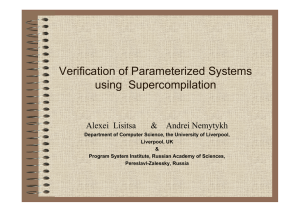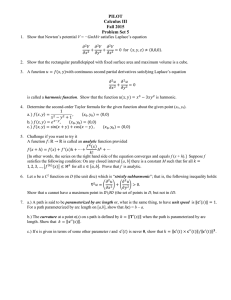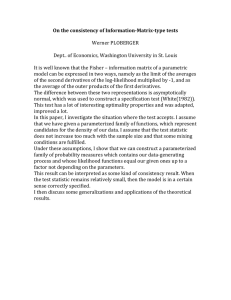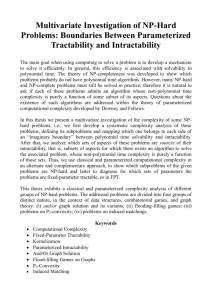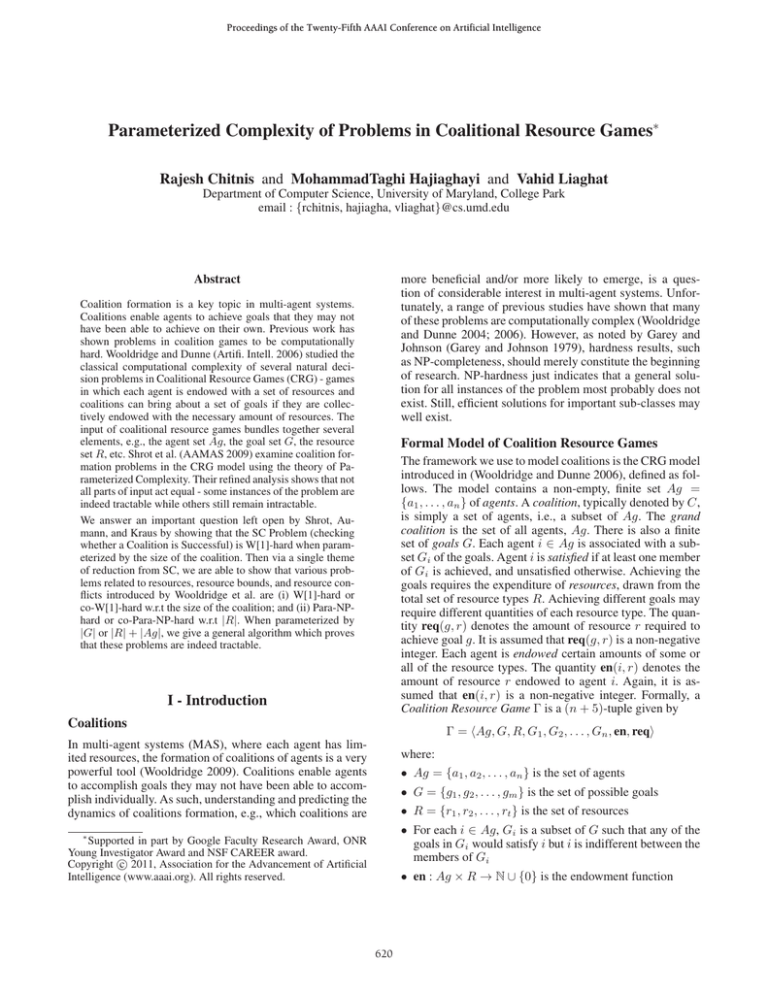
Proceedings of the Twenty-Fifth AAAI Conference on Artificial Intelligence
Parameterized Complexity of Problems in Coalitional Resource Games∗
Rajesh Chitnis and MohammadTaghi Hajiaghayi and Vahid Liaghat
Department of Computer Science, University of Maryland, College Park
email : {rchitnis, hajiagha, vliaghat}@cs.umd.edu
more beneficial and/or more likely to emerge, is a question of considerable interest in multi-agent systems. Unfortunately, a range of previous studies have shown that many
of these problems are computationally complex (Wooldridge
and Dunne 2004; 2006). However, as noted by Garey and
Johnson (Garey and Johnson 1979), hardness results, such
as NP-completeness, should merely constitute the beginning
of research. NP-hardness just indicates that a general solution for all instances of the problem most probably does not
exist. Still, efficient solutions for important sub-classes may
well exist.
Abstract
Coalition formation is a key topic in multi-agent systems.
Coalitions enable agents to achieve goals that they may not
have been able to achieve on their own. Previous work has
shown problems in coalition games to be computationally
hard. Wooldridge and Dunne (Artifi. Intell. 2006) studied the
classical computational complexity of several natural decision problems in Coalitional Resource Games (CRG) - games
in which each agent is endowed with a set of resources and
coalitions can bring about a set of goals if they are collectively endowed with the necessary amount of resources. The
input of coalitional resource games bundles together several
elements, e.g., the agent set Ag, the goal set G, the resource
set R, etc. Shrot et al. (AAMAS 2009) examine coalition formation problems in the CRG model using the theory of Parameterized Complexity. Their refined analysis shows that not
all parts of input act equal - some instances of the problem are
indeed tractable while others still remain intractable.
We answer an important question left open by Shrot, Aumann, and Kraus by showing that the SC Problem (checking
whether a Coalition is Successful) is W[1]-hard when parameterized by the size of the coalition. Then via a single theme
of reduction from SC, we are able to show that various problems related to resources, resource bounds, and resource conflicts introduced by Wooldridge et al. are (i) W[1]-hard or
co-W[1]-hard w.r.t the size of the coalition; and (ii) Para-NPhard or co-Para-NP-hard w.r.t |R|. When parameterized by
|G| or |R| + |Ag|, we give a general algorithm which proves
that these problems are indeed tractable.
Formal Model of Coalition Resource Games
The framework we use to model coalitions is the CRG model
introduced in (Wooldridge and Dunne 2006), defined as follows. The model contains a non-empty, finite set Ag =
{a1 , . . . , an } of agents. A coalition, typically denoted by C,
is simply a set of agents, i.e., a subset of Ag. The grand
coalition is the set of all agents, Ag. There is also a finite
set of goals G. Each agent i ∈ Ag is associated with a subset Gi of the goals. Agent i is satisfied if at least one member
of Gi is achieved, and unsatisfied otherwise. Achieving the
goals requires the expenditure of resources, drawn from the
total set of resource types R. Achieving different goals may
require different quantities of each resource type. The quantity req(g, r) denotes the amount of resource r required to
achieve goal g. It is assumed that req(g, r) is a non-negative
integer. Each agent is endowed certain amounts of some or
all of the resource types. The quantity en(i, r) denotes the
amount of resource r endowed to agent i. Again, it is assumed that en(i, r) is a non-negative integer. Formally, a
Coalition Resource Game Γ is a (n + 5)-tuple given by
I - Introduction
Coalitions
Γ = Ag, G, R, G1 , G2 , . . . , Gn , en, req
In multi-agent systems (MAS), where each agent has limited resources, the formation of coalitions of agents is a very
powerful tool (Wooldridge 2009). Coalitions enable agents
to accomplish goals they may not have been able to accomplish individually. As such, understanding and predicting the
dynamics of coalitions formation, e.g., which coalitions are
where:
• Ag = {a1 , a2 , . . . , an } is the set of agents
• G = {g1 , g2 , . . . , gm } is the set of possible goals
• R = {r1 , r2 , . . . , rt } is the set of resources
• For each i ∈ Ag, Gi is a subset of G such that any of the
goals in Gi would satisfy i but i is indifferent between the
members of Gi
∗
Supported in part by Google Faculty Research Award, ONR
Young Investigator Award and NSF CAREER award.
c 2011, Association for the Advancement of Artificial
Copyright Intelligence (www.aaai.org). All rights reserved.
• en : Ag × R → N ∪ {0} is the endowment function
620
• req : G × R → N ∪ {0} is the requirement function
The endowment function en extends to coalitions by summing up endowments of its members as
∀r ∈ R
en(C, r) = i∈C en(i, r)
The requirement function req extends to sets of goals by
summing up requirements of its members as
∀r ∈ R
req(G , r) = g∈G req(g, r)
Definition 1 Let Σ be a finite alphabet.
1. A parametrization of Σ∗ is a mapping κ : Σ∗ → N that
is polynomial time computable.
2. A parameterized problem (over Σ) is a pair (Q, κ) consisting of a set Q ⊆ Σ∗ of strings over Σ and a parameterization κ of Σ∗ .
As stated, given a parameterized problem we seek an algorithm that is efficient in all but the parameter. This is captured by the notion of fixed parameter tractability, as follows:
A set of goals G satisfies agent i if Gi ∩ G = ∅ and satisfies a coalition C if it satisfies every member of C. A set
of goals G is feasible for coalition C if that coalition is endowed with sufficient resources to achieve all goals in G ,
i.e., for all r ∈ R we have req(G , r) ≤ en(C, r). Finally
we say that a coalition C is successful if there exists a nonempty set of goals G that satisfies C and is feasible for it.
In general, we use the notation succ(C) = {G | G ⊆
G, G = ∅ and G is successful for C}. The CRG models many real-world situations like the virtual organizations
problem (Conitzer et al. 2006) and voting domains.
Definition 2 A parameterized problem (Q, κ) is fixed parameter tractable (FPT) if there exist an algorithm A, a constant α, and a computable function f , such that A decides
Q in time f (κ(x))|x|α .
While the core aim of parameterized complexity is to
identify problems that are fixed-parameter tractable, it has
also developed an extensive complexity theory, allowing
to prove hardness results, e.g., that certain problems are
(most probably) not FPT. To this end, several parameterized
complexity classes have been defined. Two of these classes
are W[1] and Para-NP (PNP). There is strong evidence to
believe that both these classes are not contained in FPT
(much like NP is probably not contained in P). Thus,
W[1]-hard and PNP-Hard problems are most probably not
fixed-parameter tractable. The class W[1] can be defined by
its core complete problem, defined as follows:
II - Problem Definitions and Previous Work
Problems Related to Coalition Formation
Shrot et al. 2009 considered the following four problems related to coalitions.
1. S UCCESSFUL C OALITION (SC)
Instance: A CRG Γ and a coalition C
Question: Is C successful?
2. E XISTS A S UCCESSFUL C OALITION OF S IZE k (ESCK)
Instance: A CRG Γ and an integer k
Question: Does there exist a successful coalition of size
exactly k?
3. M AXIMAL C OALITION (MAXC)
Instance: A CRG Γ and a coalition C
Question: Is every proper superset of C not successful?
4. M AXIMAL S UCCESSFUL C OALITION (MAXS)
Instance: A CRG Γ and a coalition C
Question: Is C successful and every proper superset of C
not successful?
The results from Shrot et al.2009 are summarized in the table
below.
SC
ESCK
MAXC, MAXSC
|G|
FPT
FPT
FPT
|C|
?
W[1]-H W[1]-H
|R|
para-NP-H
?
para-NP-H
|Ag| + |R| FPT
?
FPT
In this work we consider the problems which were defined by Wooldridge et al. 2006 but were not considered by
Shrot et al. 2009. We define these problems in detail in the
following sections.
S HORT N ONDETERMINISTIC T URING M ACHINE
C OMPUTATION
Instance: A single-tape, single-head non-deterministic
Turing machine M , a word x, and an integer k
Question: Is there a computation of M on input x that
reaches the accepting state in at most k steps?
Parameter: k
Note that this definition is analogous to that of NP, with
the addition of the parameter k.
Definition 3 The class W[1] contains all parameterized
problems FPT-reducible (defined hereunder) to ShortNondeterministic-Turing-Machine-Computation.
Definition 4 A parameterized problem (Q, κ) is in ParaNP (PNP) if there exists a non-deterministic Turing machine M , constant α, and an arbitrary computable function f , such that for any input x, M decides if x ∈ Q in
time ≤ |x|α f (κ(x)).
Establishing hardness results most frequently requires
reductions. In parameterized complexity, we use FPTreduction, defined as follows:
Definition 5 Let (Q, κ) and (Q , κ ) be parameterized
problems over the alphabets Σ and Σ respectively. An
FPT-reduction (FPT many-to-one reduction) from (Q, κ) to
(Q , κ ) is a mapping R : Σ∗ → (Σ )∗ such that:
Parameterized Complexity
The core idea of parameterized complexity is to single out a
specific part of the input as a parameter and ask whether the
problem admits an algorithm that is efficient in all but that
parameter. The definitions in this section are from Flum and
Grohe 2006 and Downey 2003.
1. For all x ∈ Σ∗ we have x ∈ Q ⇔ R(x) ∈ Q .
2. R is computable in time f (κ(x))|x|α for some constant α
and an arbitrary function f .
621
• Gi = {gi1 , . . . , gin } for all i ∈ [k]
k
• G = i=1 Gi
3. There is a computable function g : N → N such that
κ (R(x)) ≤ g(κ(x)) for all x ∈ Σ∗ .
• R = {r1 , . . . , rm }
III - Our Results & Techniques
We consider problems regarding resources bounds and resource conflicts which were shown to be computationally
hard in Wooldridge et al. (2006) but were not considered
in Shrot et al. We also solve three open questions posed in
Shrot et al. by showing that
1. SC parameterized by |C| is W[1]-hard
2. ESCK parameterized by |Ag| + |R| is FPT
3. ESCK parameterized by |R| is PNP-hard
We study the complexity of NR, SNR, CGRO, RPEGS,
SCRB, and CC problems when parameterized by natural parameters |G|, |C|, |R|, and |Ag|+|R|. We also give a general
integer program which with slight modifications for each
problem shows that these problems are FPT when parameterized by |G| or |Ag| + |R| (except CC parameterized by
|Ag| + |R| which is open). We note that Shrot et al. showed
that SC parameterized by |R| is PNP-hard. We complete this
hardness result by showing that SC parameterized by |C| is
W[1]-hard and thus answer their open question. Using these
hardness results and via a single theme of parameter preserving reductions we show that hardness results for all of
the above problems when parameterized by |R| and |C|. We
also show that Theorem 3.2 of (Shrot, Aumann, and Kraus
2009) is false - which claims that ESCK is FPT when parameterized by |G|. We give a counterexample to their proposed
algorithm and show that the problem is indeed PNP-hard.
These results help us to understand the role of various components of the input and identify which ones actually make
the input hard. Since all the problems we considered remain intractable when parameterized by |C| or |R|, there is
no point in trying to restrict these parameters. On the other
hand, most of the problems are FPT when parameterized by
|G| or |Ag| + |R| and thus we might enforce this restriction in real-life situations to ensure the tractability of these
problems.
Due to the lack of space some of the proofs are omitted.
The full version of the paper is available on arXiv.
• For all i ∈ [k], j ∈ [m] , en(ci , rj ) = 1
• For all i ∈ [k], j ∈ [m] and ∈ [n], we have req(gi , rj ) =
k if ej and x are incident in H and req(gi , rj ) = 0 otherwise
We claim that H has an independent set of size k if and
only if the grand coalition Ag is successful in Γ. Note that
|Ag| = k, |G| = nk, |R| = m thus this reduction shows that
the SC problem is W[1]-hard.
We note that the SC problem can be solved in O(|G||C| ×
|R|) time (since we only need to check the subsets of size
at most |C| of G) and thus SC parameterized by |C| is not
PNP-hard. Now we answer the only remaining open problem by Shrot et al. by showing that ESCK parameterized
by |R| is PNP-hard.
Theorem 2 Checking whether there exists a successful
coalition of size k (ESCK) is PNP-hard when parameterized
by |R|.
Proof. We prove this by reduction from SC which was
shown to be PNP-hard with respect to the parameter |R| in
Theorem 3.8 of (Shrot, Aumann, and Kraus 2009).
Let (Γ, C) be a given instance of SC. We consider an instance (Γ , k) of ESCK where Ag = C, R = R, k = |C|,
and Gi = Gi ∀ i ∈ C. We claim that SC answers YES if
and only if ESCK answers YES. Note that |Ag | = k, |G | =
|G|, |R | = |R| thus this reduction shows that the ESCK
problem is PNP-hard.
V - Problems Related to Resources
For a coalition C, we recollect the notation we use:
succ(C) = {G | G ⊆ G ; G = ∅ and G both satisfies
C and is feasible for it}. In this section we show hardness
results for three different problems related to resources.
IV - Problems Left Open in Shrot et al. (2009)
Necessary Resource (NR)
First we show that SC parameterized by |C| is W[1]-hard.
The idea of a necessary resource is similar to that of a veto
player in the context of conventional coalition games. A resource is said to be necessary if the accomplishment of any
set of goals which is successful for the coalition would need
a non-zero consumption of this resource. Thus if a necessary
resource is scarce then the agents possessing the resource become important. We consider the N ECESSARY R ESOURCE
problem: Given a coalition C and a resource r answer YES
if and only if req(G , r) > 0 for all G ∈ succ(C). NR was
shown to be co-NP-complete in Wooldridge et al. 2006. We
note that if C is not successful, then NR vacuously answers
YES. We give a reduction from SC to N R.
Theorem 1 SC is W[1]-hard when parameterized by |C|.
Proof. We prove this by reduction from Independent Set
(parameterized by size of independent set) which is a wellknown W[1]-complete problem. Let H = (V, E) be a graph
with V = {x1 , . . . , xn } and E = {e1 , . . . , em }. Let k be a
given integer. We also assume that H has no isolated points
as we can just add those points to the independent set and
decrease the parameter appropriately. We build a CRG Γ as
follows:
Γ = Ag, G, R, G1 , G2 , . . . , Gk , en, req
Lemma 1 Given an instance (Γ, C) of SC we can construct
an instance (Γ , C , r ) of NR such that SC answers YES iff
NR answers NO.
where
• Ag = {c1 , . . . , ck }
622
|G|
|C|
|R|
|Ag| + |R|
SC
(NPC)
FPT
W[1]-hard
PNP-hard
FPT
ESCK
(NPC)
PNP-hard
W[1]-hard
PNP-hard
FPT
NR, CGRO, RPEGS
(co-NPC)
FPT
co-W[1]-hard
co-PNP-hard
FPT
SNR
(Dp -complete)
FPT
W[1]-hard
PNP-hard
FPT
SCRB
(NPC)
FPT
co-W[1]-hard
co-PNP-hard
FPT
CC
(co-NPC)
FPT
co-W[1]-hard
co-PNP-hard
?
G ∈ succ(C). CGRO was shown to be strongly co-NPcomplete in Wooldridge et al. 2006. To prove the parameterized hardness results, we give a reduction from SC to
CGRO.
Theorem 3 The parameterized complexity status of Necessary Resource is as follows:
FPT when parameterized by |G|
co-W[1]-hard when parameterized by |C|
co-PNP-hard when parameterized by |R|
Lemma 3 Given an instance (Γ, C) of SC we can construct
an instance (Γ , C , G0 , r ) of CGRO such that SC answers
YES iff CGRO answers NO.
Proof. When parameterized by |G|, we consider all 2|G| subsets of G. For each subset, we can check in polynomial time
if it is a member of succ(C) and if it requires non-zero quantity of the resource given in the input.
The other two claims follow from Lemma 1, Theorem 3.8 in
Shrot et al., and Theorem 1.
Theorem 5 The parameterized complexity
(C, G0 , r)-Optimality is as follows:
FPT when parameterized by |G|
co-W[1]-hard when parameterized by |C|
co-PNP-hard when parameterized by |R|
Strictly Necessary Resource (SNR)
status
of
Proof. When parameterized by |G|, we consider all 2|G|
subsets of G. For each subset, we can check in polynomial
time if it is a member of succ(C) and if it requires atleast
req(G0 , r ) quantity of resource r where G0 and r are
given in the input.
The other two claims follow from Lemma 3, Theorem 3.8 in
Shrot et al., and Theorem 1.
The fact that a resource is necessary does not mean that
it will be used. Because the coalition in question can be
unsuccessful and hence the resource is trivially necessary.
So we have the S TRICTLY N ECESSARY R ESOURCE problem: Given a coalition C and a resource r answer YES
if and only if succ(C) = ∅ and ∀ G ∈ succ(C) we
have req(G , r) > 0. SNR was shown to be strongly Dp complete in Wooldridge et al. 2006. To prove the parameterized hardness results, we give a reduction from SC to SNR.
VI - Problems Related to Resource Bounds
Lemma 2 Given an instance (Γ, C) of SC we can construct
an instance (Γ , C , r ) of SNR such that SC answers YES iff
SNR answers YES.
R-Pareto Efficient Goal Set (RPEGS)
We use the idea of Pareto Efficiency to measure the optimality of a goal set w.r.t the set of all resources. In our model
we say that a goal set G is R-Pareto Efficient w.r.t a coalition C if no goal set in succΓ (C) requires at most as much
of every resource and strictly less of some resource. More
formally we say that a goal set G is R-Pareto Efficient w.r.t
a coalition C if and only if ∀ G ∈ succΓ (C),
Theorem 4 The parameterized complexity status of Strictly
Necessary Resource is as follows:
FPT when parameterized by |G|
W[1]-hard when parameterized by |C|
PNP-hard when parameterized by |R|
∃ r1 ∈ R : req(G , r1 ) < req(G , r1 ) ⇒ ∃ r2 ∈ R :
req(G , r2 ) > req(G , r2 )
Proof. When parameterized by |G|, we consider all 2|G| subsets of G. For each subset, we can check in polynomial time
if it is a member of succ(C) and if it requires non-zero quantity of the resource given in the input.
The other two claims follow from Lemma 2, Theorem 3.8 in
Shrot et al., and Theorem 1.
We note that G is not necessarily in succ(C). Thus we
have the R-PARETO E FFICIENT G OAL S ET problem: Given
a coalition C and a goal set G0 answer YES if and only
if G0 is R-Pareto Efficient w.r.t C. Wooldridge et al. 2006
show that RPEGS is strongly co-NP-complete. To prove the
parameterized hardness results, we give a reduction from SC
to RP EGS.
(C, G0 , r)-Optimality (CGRO)
We may want to consider the issue of minimizing usage of
a particular resource. If satisfaction is the only issue, then
a coalition C will be equally happy between any of the
goal sets in succ(C). However in practical situations we
may want to choose a goal set among succ(C) which minimizes the usage of some particular costly resource. Thus we
have the (C, G0 , r)-O PTIMALITY problem: Given a coalition C, resource r, and a goal set G0 ∈ succ(C) answer YES if and only if req(G , r) ≥ req(G0 , r) for all
Lemma 4 Given an instance (Γ, C) of SC we can construct
an instance (Γ , C , G0 ) of RPEGS such that SC answers
YES iff RPEGS answers NO.
Theorem 6 The parameterized complexity status of RPareto Efficient Goal Set is as follows:
FPT when parameterized by |G|
co-W[1]-hard when parameterized by |C|
co-PNP-hard when parameterized by |R|
623
Proof. When parameterized by |G|, we consider all 2|G| subsets of G. For each subset, we can check in polynomial time
if it is a member of succ(C) and if it shows that G0 is not
R-Pareto Efficient.
The other two claims follow from Lemma 4, Theorem 3.8 in
Shrot et al., and Theorem 1.
strongly co-NP-complete. To prove the parameterized hardness results, we give a reduction from SC to CC.
Lemma 6 Given an instance (Γ, C) of SC we can construct
an instance (Γ , C1 , C2 , b) of CC such that SC answers YES
if and only if CC answers NO.
Theorem 8 The parameterized complexity status of Conflicting Coalitions (CC) is as follows:
FPT when parameterized by |G|
co-W[1]-hard when parameterized by |C|
co-PNP-hard when parameterized by |R|
Successful Coalition With Resource Bound (SCRB)
In real-life situations we typically have a bound on the
amount of each resource. A resource bound is a function
b : R → N with the interpretation that each coalition has at
most b(r) quantity of resource r for every r ∈ R. We say
that a goal set G0 respects a resource bound b w.r.t. a given
CRG Γ iff ∀ r ∈ R we have b(r) ≥ req(G0 , r). Thus we
have the Successful Coalition With Resource Bound problem: Given a coalition C and a resource bound b answer
YES if and only if ∃ G0 ∈ succ(C) such that G0 respects b.
Wooldridge et al. 2006 show that SCRB is strongly NPcomplete. To prove the parameterized hardness results, we
give a reduction from SC to SCRB.
Lemma 5 Given an instance (Γ, C) of SC we can construct
an instance (Γ , C , b’) of SCRB such that SC answers YES
if and only if SCRB answers NO.
Proof. When parameterized by |G|, we consider all 2|G|
choices for G1 and G2 . Given a choice (G1 , G2 ) we can
check in polynomial time if G1 and G2 are members of
succ(C1 ) and succ(C2 ) respectively. Also we can check the
condition cgs(G1 , G2 , b) in polynomial time.
The other two claims follow from Lemma 6, Theorem 3.8 in
Shrot et al., and Theorem 1.
VIII - The Parameter |Ag| + |R| : Case of
Bounded Agents plus Resources
Considering the results in previous sections, we see that even
in the case that the size of the coalition or the number of
resources is bounded the problem remains computationally
hard. A natural question is what happens if the total number
of agents plus resources is bounded? Shrot et al. 2009 show
that by this parameterization the problems SC, MAXC, and
MAXSC have FPT algorithms and they left the corresponding question for the ESCK open. We generalize the integer
program given by Shrot et al. to give a FPT algorithm for
ESCK. By using a similar approach we design FPT algorithms for the five other problems (NR, SNR, CGRO, SCRB,
RPEGS) considered in this paper.
The integer program we define is a satisfiability problem.
It consists of a set of constraints, and the question is whether
there exists an integral solution to this set. Consider the following general integer program (which we call GIP):
xg ≥ yi (1)
∀i ∈ Ag :
Theorem 7 The parameterized complexity status of Successful Coalition With Resource Bound (SCRB) is as follows:
FPT when parameterized by |G|
co-W[1]-hard when parameterized by |C|
co-PNP-hard when parameterized by |R|
Proof. When parameterized by |G|, we consider all 2|G| subsets of G. For each subset,we can check in polynomial time
if it is a member of succ(C) and if it requires non-zero quantity of the resource given in the input.
The other two claims follow from Lemma 5, Theorem 3.8 in
Shrot et al., and Theorem 1.
VII - Problems Related to Resource Conflicts
Conflicting Coalitions (CC)
When two or more coalitions desire to use some scarce resource, it leads to a conflict in the system. This issue is
a classic problem in distributed and concurrent systems.
In our framework we say that two goal sets are in conflict w.r.t a resource bound if they are individually achievable within the resource bound but their union is not. Formally a resource bound is a function b : R → N with
the interpretation that each coalition has at most b(r) quantity of resource r for every r ∈ R. We say that a goal
set G0 respects a resource bound b w.r.t. a given CRG
Γ if and only if ∀ r ∈ R we have b(r) ≥ req(G0 , r).
We denote by cgs(G1 , G2 , b) the fact that G1 and G2 are
in conflict w.r.t b. Formally, cgs(G1 , G2 , b) is defined as
respects(G1 , b) ∧ respects(G2 , b) ∧ ¬respects(G1 ∪ G2 , b).
Thus we have the C ONFLICTING C OALITIONS problem:
Given coalitions C1 , C2 and a resource bound b answer YES
if and only if ∀ G1 ∈ succ(C1 ) and ∀ G2 ∈ succ(C2 ) we
have cgs(G1 , G2 , b). Wooldridge et al. 2006 show that CC is
∀r ∈ R :
g∈G
xg × req(g, r) ≤
g∈Gi
yi × en(i, r)
(2)
i∈Ag
yi , xg ∈ {0, 1}
In this setting for each i ∈ Ag, yi indicates the event that
agent i is participating in the coalition and for each g ∈ G,
xg indicates the event that goal g is achieved. One can show
that any solution for GIP is a coalition of agents and a successful set of goals for that coalition.
The above integer program has |Ag| + |R| constraints and
in Flum and Grohe 2006 it is shown that I NTEGER L IN EAR P ROGRAMMING is FPT wrt number of constraints or
number of variables. We give tractable algorithms for each
problem by adding a few constraints to our general integer
program.
Theorem 9 ESCK parameterized by |Ag| + |R| is FPT.
624
which means that |C | = |Ag| > k and so the algorithm
answers NO while the correct answer is YES. Indeed by reducing Independent Set to a CRG instance with |G| = 1, we
prove the following theorem.
Theorem 11 ESCK parameterized by |G| is PNP-hard.
Proof. In ESCK we have to insure that exactly k number of agents will be selected. Therefore adding the constraint i∈Ag yi = k to GIP gives the integer program for
the ESCK problem. Since the number of constraints, (i.e.,
|Ag| + |R| + 1) is fixed the proof is complete.
In the other five problems NR, SNR, CGRO, SCRB, and
RPEGS the coalition C is given. Thus we change the variables yi ’s to constants where yi is set to 1 iff i ∈ C. We call
this new integer program a Fixed Coalition Integer Program (FCIP). It is clear that a coalition is successful if and
only if FCIP is satisfiable.
X - Directions for Future Work
The study of problems arising in coalitions of agents in
multi-agents systems using the parameterized complexity
paradigm was initiated by Shrot et al. In this paper we have
tried to take a further step in this direction which we believe
is still unexplored. There are various (classically) computationally hard problems which need to be better analyzed
through the rich theory of parameterized complexity.
Both in Shrot et al. and this paper only the CRG model has
been considered. In CRG model the status of CC parameterized by |Ag| + |R| is left open. Alternatively one might
consider other natural parameters like |Ag| or try to examine
other models like the QCG model (Wooldridge et al. 2004)
through parameterized complexity analysis.
Theorem 10 When parameterized by |Ag| + |R|, the NR,
SNR, CGRO, SCRB, and RPEGS problems are FPT.
Proof. Due to the lack of space we omit the details and we
only mention the required changes for each problem.
• NR: For all goals g ∈ G where req(g, r) > 0 we change
the variable xg to zero.
• SNR: First we should check if the coalition is successful. If FCIP was satisfiable, for all goals g ∈ G where
req(g, r) > 0 we have to set the variable xg to zero.
• CGRO: We add the constraint g∈G xg × req(g, r) < β
where β = req(G0 , r).
Acknowledgments
We would like to thank Yuk Hei (Tom) Chan, Dana Nau, and
Kanthi Sarpatwar for helpful discussions.
• SCRB: For every resource
r ∈ R we bound its usage by
adding the constraint g∈G xg × req(g, r) ≤ b(r).
References
Conitzer, V., and Sandholm, T. 2006. Complexity of constructing solutions in the core based on synergies among
coalitions. Artificial Intelligence 170(6-7):607–619.
Downey, R. G., and Fellows, M. R. 1995. Fixed-parameter
tractability and completeness ii: On completeness for W[1].
Theo. Comp. Sc. 141(1&2):109–131.
Downey, R. 2003. Parameterized complexity for the skeptic.
In CCC’03, 147–169.
Flum, J., and Grohe, M. 2006. Parameterized Complexity
Theory. Springer-Verlag New York.
Garey, M. R., and Johnson, D. S. 1979. Computers and
Intractability: A Guide to the Theory of NP-Completeness.
Shrot, T.; Aumann, Y.; and Kraus, S. 2009. Easy and hard
coalition resource game formation problems: a parameterized complexity analysis. In AAMAS (1), 433–440.
Wooldridge, M., and Dunne, P. E. 2004. On the computational complexity of qualitative coalitional games. Artificial
Intelligence 158(1):27–73.
Wooldridge, M., and Dunne, P. E. 2006. On the computational complexity of coalitional resource games. Artificial
Intelligence 170(10):835–871.
Wooldridge, M. 2009. An Introduction to Multiagent Systems. Chichester, UK: Wiley, 2nd edition.
• RPEGS: Since G0 is given, req(G0 , r) is known to us.
We write |R| instances of FCIP such that in the FCIP
for resource r, we have the constraint req(G , r) <
req(G0 , r), and |R| − 1 constraints req(G , r ) ≤
req(G0 , r ), one for each resource r = r.
IX - Revisiting ESCK Parameterized by |G|
Shrot et al. (Shrot, Aumann, and Kraus 2009) show in Theorem 3.2 of their paper that ESCK parameterized by |G| is
FPT. We first show their proposed FPT algorithm is wrong
by giving an instance when their algorithm gives incorrect
answer. Then we show that in fact the problem is PNP-hard
via a reduction from the independent set problem.
Counterexample to the Algorithm Given in
Theorem 3.2 of Shrot et al. 2009
The algorithm is as follows:
1. For each G ⊆ G
• Let C be set of all agents satisfied by G
• If |C | =
k , go to 1.
• If G is feasible for C , return TRUE
2. return FALSE
We give an instance Γ where the above algorithm gives an
incorrect answer. Suppose |Ag| > k, each agent has 1 unit
of endowment of each resource, each goal requires 0 of each
resource, and Gi = G for all agents i ∈ Ag. Thus each
coalition is successful and ∀ G ⊆ G we have C = Ag
625

